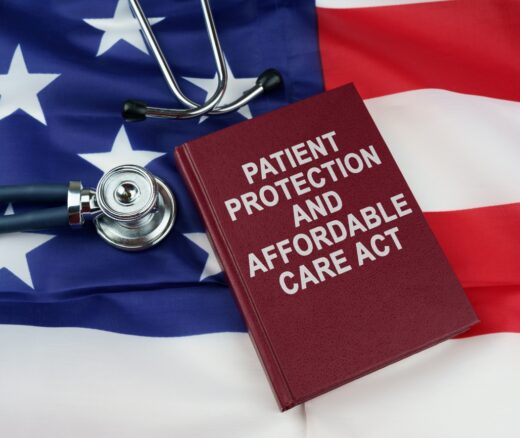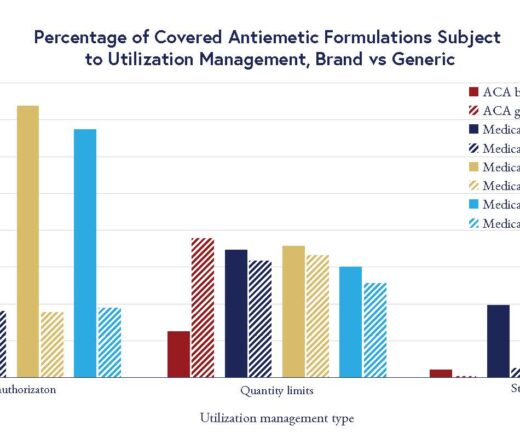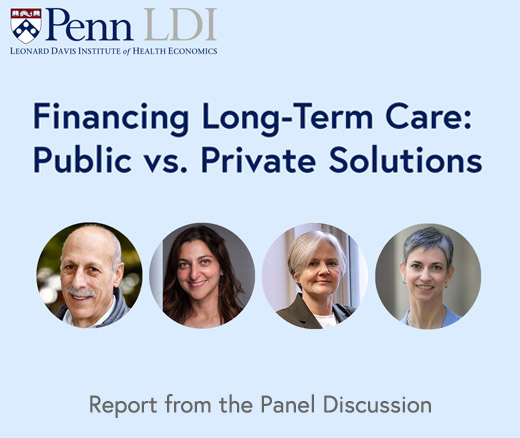
How Republicans Could Fashion a Practical Option to Obamacare
An LDI Expert Offers Three Recommendations That Address Core Criticisms of the ACA’s Model
Substance Use Disorder
News | Video
From April 2020 through April 2021, there were 100,300 drug overdose deaths across the country according to the CDC — a 28.5% increase over the previous year. Some 75% of these were opioid-related overdoses that killed an average of nine users an hour around the clock throughout the year. Looking forward, the just-published Stanford-Lancet Commission on the North American Opioid Crisis predicts that 1.2 million more opioid users will die of overdoses by 2029.
Against this background, the University of Pennsylvania’s Leonard Davis Institute of Health Economics (Penn LDI) convened a March 4, 2022, panel of four top experts to discuss the current efforts to address this rapidly growing public health crisis. The panel included the head of the Stanford-Lancet Commission as well as the former Acting Director of the Office of National Drug Control Policy, the Associate Dean for Social Justice at the University of Southern California’s School of Medicine, and moderator Shoshana Aronowitz, PhD, MSHP, LDI Senior Fellow, and Penn School of Nursing researcher whose work is focused on equitable access to substance use treatment and harm reduction services.
The virtual event was co-sponsored with the Center for Health Economics of Treatment Interventions for Substance Use Disorder, HCV, and HIV (CHERISH).
Synopsizing the bottom line of the national challenge to reduce this overdose epidemic, panelist and USC Professor Ricky Bluthenthal, PhD — who has been researching substance use interventions for 30 years — pointed to the lack of coherent government action and policies.

“We haven’t had the kind of local, state, and national response to this crisis that we need to,” Bluthenthal said. “We actually have many effective solutions, most of which involve engagement with people with lived experience, and the distribution of things like naloxone, safe injection supplies, drug consumption sites, and the like. There are a lot of things we could be doing if we were willing to take them to scale, but we now need to step up our game in terms of things that we can do right now that would facilitate access to medications for opioid use disorder and provide delivery systems that actually get those services to the people who need them.”
Regina LaBelle, JD, Director of the Addiction and Public Policy Initiative at Georgetown University’s O’Neill Institute for National and Global Health Law, noted: “When the April 2021, numbers were announced, there was a lot of shock, but anyone who had been paying attention could see this building in the various models being done. Some policy improvements were made in the Obama and Biden administrations, but some of the basic conditions remain. We have a lack of evidenced-based treatment availability. We have huge amounts of stigma associated with both people who may use drugs as well as stigma about even seeking treatment.”
Aronowitz noted that, although alarming, the latest mortality statistics fail to convey the full scope of the problem because they don’t count near-fatal overdoses. “Emergency department numbers for overdoses are five times those of deaths — and half of overdoses are self managed,” she said. “Non-fatal overdoses strongly predict eventual overdose death. Are we using this information to agitate for change?”

LaBelle acknowledged the enormity of that data collection challenge. “Traditionally, we measure how well we’re doing based on the rate of overdose deaths, when that’s only the tip of the iceberg,” she said. “We just don’t have great data on overdoses that don’t end in death. That underscores for me why naloxone should be more widely available. I don’t see the reason why it has to be prescribed rather than made readily available over the counter to substance users at great risk.”
Stanford Professor of Psychiatry and Behavioral Sciences Keith Humphreys, PhD, pointed out that “naloxone distribution is the number one thing the Stanford-Lancet Commission model found to save lives — we need a dramatic expansion of naloxone distribution,” he said. “If we could boost current levels of availability by a third, we would reduce hundreds of thousands of deaths over this next decade.”
At the same time, Humphreys emphasized that the overall policy focus has to be greatly broadened because overdose deaths and near deaths occur in the extreme downstream of the crisis.
“We have to understand that much the same as monoclonal antibodies are great for people who are intubated with serious cases of COVID-19, naloxone serves only the immediate condition of overdose. But you will never solve either epidemic by just taking care of people at that extreme downstream end,” Humphreys said. “You have to go upstream. In COVID, that means preventive measures like vaccines, masks, social distancing, and such. In substance use disorder, that means investing in kids — I’m not talking about ‘just say no’ programs, but rather things like nurse-family partnerships, Head Start, pre-K. We need interventions that set kids off on a good start in life, particularly kids in low-income neighborhoods and places that have already gone through a generation of addiction. It has been very hard to persuade politicians and the public to make 20-year investments, but we really need to think that way.”

“It also means we need to make sure we separate our health care institutions, our regulators, and our educational institutions from corporate interests that profit from the spread of addiction,” Humphreys continued. “We need to tighten up the regulatory system. There is no reason why 10 years from now we couldn’t have another epidemic like this one started in the health care system with a different drug, like stimulant medications or benzodiazepines, or we would not have approved ketamine that’s now out there. We may soon approve MDMA. And the holes that companies like Purdue Pharma walked through largely remain. The political influence of the industry and their ability to advertise beyond any sane amount needs to be fixed on the preventive side. I know it’s hard to think long term when we’ve got a crisis on our hands, but we have to do both things. We have to manage those people who have the problem, and we have to stop future generations from going through the same thing.”
Along with much wider naloxone availability, evidence-based MOUD treatments, Emergency Department engagement programs, and retaining the new pandemic-driven flexibilities in telehealth and other treatment modalities, the panelists emphasized two other areas of policy reform that could have potentially outsize impact. The first is expanding Medicaid in those states that haven’t yet done so to provide coverage for in-patient and out-patient substance use treatment. The second is overhauling the addiction-related regulations and practices in correctional facilities that house such large populations of drug users.
LaBelle noted “we know that you’ve got up to a 40 percent greater chance of overdosing if you are not treated with a Medication for Opioid Use Disorder (MOUD) while you are incarcerated. First of all, it’s against the law to force someone on methadone or buprenorphine to stop and go into withdrawal when they enter corrections. From federal court cases we know that’s a violation of the Americans with Disabilities Act. It’s also a violation of the Eighth Amendment.”

“At Georgetown,” LaBelle continued, “we worked with the Sheriffs’ Association and the Bureau of Prisons on this issue, and there is a great interest in expanding access to treatment and corrections to evidence-based treatment. Groups like the National Sheriffs’ Association and others are calling for the elimination of the Medicaid Exception (that bars the use of Medicaid funds to cover inmate health care services). So the proposed Medicaid Reentry Act would allow incarcerated individuals to get Medicaid coverage for addiction treatment starting 30 days before their release.” Once released, the former inmates are again eligible for ongoing Medicaid coverage of their continuing treatment.
“We know from Rhode Island’s experience how they decreased overdose deaths in the reentry population by 60 percent and six percent overall in the state by implementing Medicaid-based treatment in corrections,” LaBelle said.
Humphreys, who has visited that Rhode Island Department of Corrections prison in Cranston, agreed. “It’s really a terrific model of continuity of care,” he said. “You have the same provider when people are incarcerated and when they go back out into the community. This is so important because we lose a lot of people in that first two weeks after prison — the death rate is just appalling. It’s like being in combat. It’s not enough to say, ‘Well, there’s a clinic out there somewhere. Good luck finding it.’ Instead, they have someone they know meeting them at the exit gate and taking them to treatment somewhere they already know. It’s remarkable how lifesaving this is.”
While that Rhode Island program works well, Bluthenthal pointed out that not-in-my-backyard (NIMBY) political resistance frequently preventing the siting of treatment facilities is a major reason easily accessible treatment sites are in critically short supply.
“Currently, the kinds of treatment and harm reduction services available to people are better understood by politics rather than need,” Bluthenthal said. “It has a devastating consequence for people of color and other minority populations because they end up not getting the service they need or they get the negative intervention — mass incarceration. It’s a problem with our politics — these NIMBY-driven decisions are very narrow minded.”
As the session ended, Aronowitz asked the three panelists their thoughts on the most important thing that needs to be done more or differently to better address the opioid crisis. Their answers:
Humphreys: “We need the criminal justice system to stop punishing and start engaging in rehabilitation, and the health care system to take on substance use disorder permanently as an enduring condition of life like heart disease or cancer, so that every single health care system is competent to provide treatment. And we need to fix the holes in the pharmaceutical regulatory framework.”
Bluthenthal: “To make all the things we’ve been talking about work, we need to have an infrastructure that reaches these populations. We have to invest in community-based organizations and people with lived experience to staff them so they have the jobs and can connect the effective treatment services to the people who need them.”
LaBelle: “At Georgetown, I’ve started a year-long Master’s of Science in Addiction Policy and Practice program to marry science research with policy. We have a class of 10 people now; and every year, I’m going to have more coming through this program so we can have an addiction policy that’s based on science, evidence, and compassion.”


An LDI Expert Offers Three Recommendations That Address Core Criticisms of the ACA’s Model

Administrative Hurdles, Not Just Income Rules, Shape Who Gets Food Assistance, LDI Fellows Show—Underscoring Policy’s Power to Affect Food Insecurity

Chart of the Day: LDI Researchers Report Major Coverage Differences Across ACA and Medicaid Plans, Affecting Access to Drugs That Treat Chemo-Related Nausea

A Penn LDI Virtual Panel Looks Ahead at New Possibilities

Insurers Avoid Counties With Small Populations and Poor Health but a New LDI Study Finds Limited Evidence of Anticompetitive Behavior

The Evidence Suggests a Ban on Ads May Not Be A Well-Targeted Solution